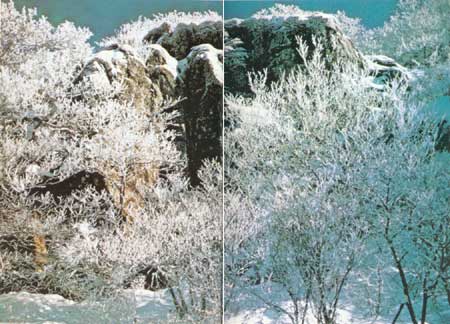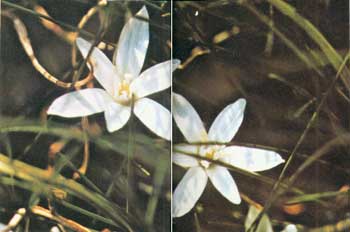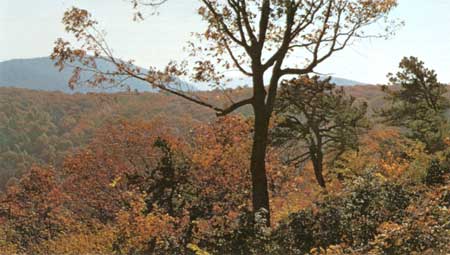|
SHENANDOAH National Park |
 |
The Seasons
Summer is the biological peak of the Shenandoah year. Plants make food and the great pyramid of animal life dependent on them does most of its reproducing in this green season. Humans, too, are most abundant in the park during this vacation season. But the climax of the yearly story has little meaning apart from its beginning and its end. And it gives not a hint of the different beauty preceding and following it.
Come during the mid-winter sleep and you may find a world of dazzling beauty. In winter, the clearest season, the ridges north, south, and west often stand sharply etched against a blue sky. Geologic and forest patterns are more easily seen. On the heights, a foot or two of snow may cover the ground; and you may, if especially lucky, arrive on one of those few days when ice coats every branch, sparkling in the sun like a million diamonds.
But winter, of course, can also be severe. Temperatures on the ridge may be near zero, with bitter winds sweeping up the west slopes. Snowstorms may temporarily close Skyline Drive; but sections are cleared within a few days, so try the Drive in the winter for crystal views on clear days. If you're a hardy soul, bundle up for an invigorating hike. There is life as well as scenery to be seen.

At first glance, the forest may seem empty, with nothing stirring and no sounds heard except the wind and the crunching of your feet on the snow. This is a realistic appraisal, but actually a great deal of life is here—sleeping, as it were. Trees and shrubs maintain themselves with food made in their leaves during summer and stored in roots and stems. Many perennials whose upper parts die survive the winter with underground roots. Under bark and within wood, eggs and larvae of billions of insects escape the cold winds of winter, while some species, such as the mourning cloak butterfly, winter in the adult stage, by hibernating. Part of the mammal population is sleeping, too. Chipmunks and woodchucks doze in their burrows, though warm weather can bring them out for a while. Bears in Shenandoah seem to sleep away the periods of severe weather, but forage during milder spells. Some of the park's bats avoid winter by migrating south; others, such as the common little brown bat, stay put, hibernating in hollow trees and in buildings.
Though it is hard to detect beneath the ice and snow, there is activity in streams, where the temperature, of course, is above freezing. Crayfish and insect larvae sift through bottom debris for food, while fish hunt plantlife, invertebrates, or smaller fish. Stream-inhabiting salamanders remain active in their moderate environment, but frogs must retire for the winter, hibernating in mud.
Even though most animal life is out of sight, you will have furred and feathered company on your winter hike. Deer and squirrels can be seen more easily in the leafless woods, and patterns in the snow reveal that bears, bobcats, raccoons, foxes, 'possums, or skunks have passed your way. Inspecting more closely, you will no doubt see where a little white-footed or deer mouse has pitter-pattered from one clump of vegetation to another.
Birds will be the most visible creatures. Many of the park's birds migrate south for the winter, but a sizeable contingent remains. You will probably meet a band or two of chickadees, titmice, nuthatches, and woodpeckers, which all forage together at this time of year, inspecting crevices and drilling into wood for insect eggs and larvae. Though they all seek the same general kind of food, there is specialization among them. Nuthatches work on tree trunks and larger limbs, chickadees and titmice on smaller branches—the acrobatic chickadees often feeding upside down on the under surfaces of the branches. Woodpeckers, too, divide their hunting area, the larger species drilling into the thicker parts of trees while the downy woodpecker spends more time on small stems. One advantage of this mixed flocking may be that many eyes can spot predators more quickly: Cooper's and sharp-shinned hawks are a constant threat to small birds.
Most of the other common winter birds eat seeds or berries. In the more open areas you may find cardinals, juncos, goldfinches, and song, tree, and white-throated sparrows. And perhaps a flock of robins or cedar waxwings will appear. Most exciting is the sudden burst of a ruffed grouse flushed from the trailside, or the dark forms of turkeys trotting up a slope.
Perhaps because they are so few, we doubly enjoy the winter animals.
Who knows when spring begins in Shenandoah? For some, it is the swelling of red maple buds; for others, the first hepatica blossom peaking through dead leaves; for still others, the first mourning cloak butterfly flitting through snow-patched woods. Park people living at Big Meadows, however, listen for two special sounds. One is the quacking of wood frogs in Big Meadows swamp, and the other is the nasal beeping of woodcocks, which signals that these droll birds with the big eyes and long bills have returned from lands farther south and are starting their courtship flights.
All these events usually take place in March. Though they herald a new season, the mountain aspect is still decidedly wintry. By May, a green wave has begun to wash up the slopes. When it starts, icicles may still be hanging from the face of Stony Man, and oak buds on the ridges are still tightly closed. But as the upper elevations warm, winter gray gives way to spring green, some say at the rate of 100 feet of elevation a day. By early June, even the mountaintop oaks have reluctantly unfurled, and the Blue Ridge once again is fully clothed.
Leafing of the forest trees is a profoundly important event, for it provides new food for a myriad of animal forms, and it changes conditions on the forest floor. Most forest wildflowers do their blooming and photosynthesizing of food, using the sun's energy while it still reaches their leaves, during April and May, before the foliage of the canopy trees intercepts most of the sunlight. At this time bloodroot, spring beauty, toothwort, bluet, trillium, and a host of other wildflowers spangle the ground, and at the lower elevations, redbud and dogwood enliven the forest understory. Tree leafing has a positive effect on emerging insects, supplying them with an abundance of food. And they, in turn, feed the thousands of returning birds.
The migrant flocks contain many species that settle in Shenandoah and also many that require more northerly climes. Though at least 18 species of warblers breed in the park, several members of this brightly colored clan continue farther, some to the limit of tree growth in Canada. Water birds, headed for northern marshes or tundra, occasionally put down in the park. One foggy morning, Park Naturalist John Davis found a dunlin (red-backed sandpiper) resting on the grass at Thornton Gap, a long way from the nearest beach or mudflat.
As the warming spring air gradually seeps into burrows, logs, and dens, it wakes not only dormant mammals but also hibernating snakes. Generally the smaller species, such as ring-necked and garter snakes, come out first. By May or June, rattlesnakes and copperheads have emerged from the rocky dens, where they have wintered in large groups, to spread out over the surrounding terrain.
Shenandoah's streams become most exuberant in spring. Full to the brim, they shout and tumble down the mountainsides and make photographers happy. The life within them is exuberant, too, as aquatic insects transform into winged adults, to mate, lay eggs, and feed leaping trout. Many of the amphibians follow suit, laying their eggs in streams and temporary pools. Trilling of toads, peeping of spring peepers, and snoring of pickerel frogs are the sounds of males advertising for females. Salamanders, while quiet about it, seem to have no trouble finding each other.
Paradoxically, spring, when moisture seems abundant, is the park's worst season for fires. With snow gone, temperatures rising, many dead leaves on the ground, and new foliage not yet out, conditions are right for fires. When the ridgetop oaks fully open the palms of their leaves, thus signaling the beginning of summer, park fire-fighters no doubt breathe a little easier.

(Photo by Ross Chapple)
Ah, summer! Perhaps in no other season do lowlanders appreciate Shenandoah more, for that is when hot, humid air settles over the coastal strip for days at a time. A drive to the Blue Ridge leaves much of that behind, refreshes the spirit, and reminds one that there are purer parts of the world. Though afternoon thunderstorms often drench the mountains, extended rains are rare. It's a pleasant season for walking, especially on the shadier eastern slopes.
Summer is decidedly a family time in the park, and not only for humans. Birds are raising young, swarms of tadpoles are growing toward froghood, eggs of box turtles and snakes are hatching in the warm soil, and insects are making their annual effort to inherit the earth.
A majority of mammal young have been born earlier, in the spring, and now, under parental tutelage, grow slowly toward maturity and independence. Bear cubs, born in dens very early in spring, now follow their mothers with agility and learn about ants in logs and a thousand other bear-food sources. Spotted fawns, born in May or June, lie concealed where their mothers left them, and later discover that leaves and buds taste as good as mother's milk. The young deer will stay with their mothers until the following winter, and the cubs until the next summer. But the young of smaller mammals mature faster, the period of dependency more or less shortening as size of animals decreases. Most of the smaller mammals have one litter a year, but mice and shrews may raise three or four. The prolific cottontail rabbit is even busier, sometimes producing five sets of young in a year.
During the three summer months, our attention is drawn from one part of the natural drama to another. June is filled with bird song, as males proclaim their territories, and mountain laurel and azalea brighten much of the forest. Moist, rocky roadsides along the Drive begin their summer show with blossoms of goatsbeard, trumpet honeysuckle, wild hydrangea, New Jersey tea, thimbleberry, and other plants. Big Meadows has an interesting assortment, too, with plants more tolerant of open sunlight. Down in the grass, wild strawberries now offer their delicious fruit, while several species of lilies bloom conspicuously.
Bird song fades in the last half of July, as young birds are on the wing and wandering. Now begins the late-summer spectacle of asters, Joe-Pye-weed, and other composites. Just as characteristic of this time are the monotonous rasping calls of false katydids and cicadas; and from now into the fall, grasshoppers in profusion hop through the grass. By late August, a few migrating birds have appeared and some leaves of black gum and Virginia creeper have turned red, giving advance notice of the autumn blaze to come.
Selected Seasonal Events
| The events listed below occur, under typical conditions, during the months (divided into 10-day periods) indicated. | Jan | Feb | Mar | Apr | May | Jun | Jul | Aug | Sep | Oct | Nov | Dec | ||||||||||||||||||||||||
| Bear cubs born in dens | ||||||||||||||||||||||||||||||||||||
| Woodchucks end hibernation | ||||||||||||||||||||||||||||||||||||
| Hepaticas bloom | ||||||||||||||||||||||||||||||||||||
| Wood frogs breed | ||||||||||||||||||||||||||||||||||||
| Woodcocks return to Big Meadows | ||||||||||||||||||||||||||||||||||||
| Main period, spring bird migration | ||||||||||||||||||||||||||||||||||||
| Dogwoods bloom | ||||||||||||||||||||||||||||||||||||
| Tree leafing at Big Meadows | ||||||||||||||||||||||||||||||||||||
| Deer fawns born | ||||||||||||||||||||||||||||||||||||
| Main period, bird nesting | ||||||||||||||||||||||||||||||||||||
| Trilliums bloom | ||||||||||||||||||||||||||||||||||||
| Mountain laurels bloom | ||||||||||||||||||||||||||||||||||||
| Milkweeds bloom | ||||||||||||||||||||||||||||||||||||
| Goldenrods bloom | ||||||||||||||||||||||||||||||||||||
| Asters bloom | ||||||||||||||||||||||||||||||||||||
| Cicadas calling | ||||||||||||||||||||||||||||||||||||
| Main period, fall bird migration | ||||||||||||||||||||||||||||||||||||
| Witchhazels bloom | ||||||||||||||||||||||||||||||||||||
| Main period, fall color | ||||||||||||||||||||||||||||||||||||
| Deer rut | ||||||||||||||||||||||||||||||||||||
| Brook trout spawn | ||||||||||||||||||||||||||||||||||||
In many ways, fall is the reverse of spring. The insects, mammals, and snakes that emerge latest in spring are usually the earliest to disappear in fall. Many late-migrating spring birds return on their southward trip early in fall. Autumn colors first appear on the ridgetops and then creep downward.
Bird migration occurs mainly in September and early October as warblers, vireos, thrushes, flycatchers, and other small birds stream south along the ridges by night and feed and rest by day. They seem to be much more abundant in the Blue Ridge in fall than in spring, perhaps mainly because leaves are not far out at high elevations during the spring migration. Traveling by day, hawks drift along the ridges on west or northwest winds. The top of Big Flat Mountain (site of the Loft Mountain campground) and Marys Rock (south of Thornton Gap) are good spots from which to watch this exciting spectacle. Be sure winds are propitious or you may draw a blank on hawks. Most spectacular are occasional heavy flights of broad-winged hawks in mid- or late September.

(Photo by Bill Perry)
Though spots of color have been slowly increasing since August, the major show comes in October. The blaze seems to begin on ridges and dry southwest slopes, marked by the yellows of chestnut oak and hickory. The conflagration is soon intensified with the purple of ashes and red of red maples, and reaches its peak—usually in mid-October—when the yellows of striped and mountain maples, birches, and tulip trees, and the reds of white and red oaks join in. In case you need an explanation for all this beauty, scientists have a partial one. Loss of green chlorophyll during the lengthening nights has revealed the yellow pigments that are always present in some species, and warm days and cool but not freezing nights have encouraged production of the red and purple pigments in others.
By November, few insects are about; most have been killed or sent into hibernation by frosts. The trees have lost most of their leaves. Reptiles and amphibians have gone underground to maintain acceptable body temperatures. A few robins and blue jays are still straggling southward, but birds are now scarce. Perhaps a bald or a golden eagle will pause for a few days and then depart in search of better hunting grounds. A final burst of reproductive activity occurs as trout spawn in gravelly pools and bucks fight for does. One day, snow falls in earnest. The quiet of winter returns.

|

|
| NPS History | History & Culture | National Park Service | Contact |
|
Last Modified: Sat, Nov 4 2006 10:00:00 pm PST |


